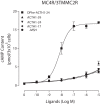Third transmembrane domain of the adrenocorticotropic receptor is critical for ligand selectivity and potency
- PMID: 25605722
- PMCID: PMC4367271
- DOI: 10.1074/jbc.M114.596122
Third transmembrane domain of the adrenocorticotropic receptor is critical for ligand selectivity and potency
Abstract
The ACTH receptor, known as the melanocortin-2 receptor (MC2R), plays an important role in regulating and maintaining adrenocortical function. MC2R is a subtype of the melanocortin receptor (MCR) family and has unique characteristics among MCRs. Endogenous ACTH is the only endogenous agonist for MC2R, whereas the melanocortin peptides α-, β-, and γ-melanocyte-stimulating hormone and ACTH are full agonists for all other MCRs. In this study, we examined the molecular basis of MC2R responsible for ligand selectivity using ACTH analogs and MC2R mutagenesis. Our results indicate that substitution of Phe(7) with D-Phe or D-naphthylalanine (D-Nal(2')) in ACTH(1-24) caused a significant decrease in ligand binding affinity and potency. Substitution of Phe(7) with D-Nal(2') in ACTH(1-24) did not switch the ligand from agonist to antagonist at MC2R, which was observed in MC3R and MC4R. Substitution of Phe(7) with D-Phe(7) in ACTH(1-17) resulted in the loss of ligand binding and activity. Molecular analysis of MC2R indicated that only mutation of the third transmembrane domain of MC2R resulted in a decrease in D-Phe ACTH binding affinity and potency. Our results suggest that Phe(7) in ACTH plays an important role in ligand selectivity and that the third transmembrane domain of MC2R is crucial for ACTH selectivity and potency.
Keywords: 7-Helix Receptor; Cyclic AMP (cAMP); G Protein-coupled Receptor (GPCR); Membrane Protein; Peptide Hormone.
© 2015 by The American Society for Biochemistry and Molecular Biology, Inc.
Figures







Similar articles
-
Molecular determinants of ACTH receptor for ligand selectivity.Mol Cell Endocrinol. 2020 Mar 1;503:110688. doi: 10.1016/j.mce.2019.110688. Epub 2019 Dec 19. Mol Cell Endocrinol. 2020. PMID: 31866318 Review.
-
Amino acid residue L112 in the ACTH receptor plays a key role in ACTH or α-MSH selectivity.Mol Cell Endocrinol. 2019 Feb 15;482:11-17. doi: 10.1016/j.mce.2018.12.002. Epub 2018 Dec 13. Mol Cell Endocrinol. 2019. PMID: 30553806
-
Cysteine residues are involved in structure and function of melanocortin 1 receptor: Substitution of a cysteine residue in transmembrane segment two converts an agonist to antagonist.Biochem Biophys Res Commun. 2001 Mar 9;281(4):851-7. doi: 10.1006/bbrc.2001.4429. Biochem Biophys Res Commun. 2001. PMID: 11237737
-
Common requirements for melanocortin-4 receptor selectivity of structurally unrelated melanocortin agonist and endogenous antagonist, Agouti protein.J Biol Chem. 2001 Jan 12;276(2):931-6. doi: 10.1074/jbc.M007261200. J Biol Chem. 2001. PMID: 11024027
-
60 YEARS OF POMC: Melanocortin receptors: evolution of ligand selectivity for melanocortin peptides.J Mol Endocrinol. 2016 May;56(4):T119-33. doi: 10.1530/JME-15-0292. Epub 2016 Jan 20. J Mol Endocrinol. 2016. PMID: 26792827 Review.
Cited by
-
ACTH Receptor (MC2R) Specificity: What Do We Know About Underlying Molecular Mechanisms?Front Endocrinol (Lausanne). 2017 Feb 6;8:13. doi: 10.3389/fendo.2017.00013. eCollection 2017. Front Endocrinol (Lausanne). 2017. PMID: 28220105 Free PMC article. Review.
-
The incidence of candidate binding sites for β-arrestin in Drosophila neuropeptide GPCRs.PLoS One. 2022 Nov 1;17(11):e0275410. doi: 10.1371/journal.pone.0275410. eCollection 2022. PLoS One. 2022. PMID: 36318573 Free PMC article.
-
A Rare Presentation of Homozygous Pathogenic Variant in MC2R Gene with Salt-Wasting Crisis in a Neonate.Mol Syndromol. 2024 Feb;15(1):77-82. doi: 10.1159/000533986. Epub 2023 Oct 2. Mol Syndromol. 2024. PMID: 38357256 Free PMC article.
-
Ligands for Melanocortin Receptors: Beyond Melanocyte-Stimulating Hormones and Adrenocorticotropin.Biomolecules. 2022 Oct 1;12(10):1407. doi: 10.3390/biom12101407. Biomolecules. 2022. PMID: 36291616 Free PMC article. Review.
-
A Novel Homozygous MC2R Variant Leading to Type-1 Familial Glucocorticoid Deficiency.J Endocr Soc. 2022 Apr 8;6(6):bvac058. doi: 10.1210/jendso/bvac058. eCollection 2022 Jun 1. J Endocr Soc. 2022. PMID: 35506146 Free PMC article.
References
-
- Clark A. J., Weber A. (1998) Adrenocorticotropin insensitivity syndromes. Endocr. Rev. 19, 828–843 - PubMed
-
- Clark A. J., Metherell L. A., Cheetham M. E., Huebner A. (2005) Inherited ACTH insensitivity illuminates the mechanisms of ACTH action. Trends Endocrinol. Metab. 16, 451–457 - PubMed
-
- Shepard T. H., Landing B. H., Mason D. G. (1959) Familial Addison's disease; case reports of two sisters with corticoid deficiency unassociated with hypoaldosteronism. AMA J. Dis. Child 97, 154–162 - PubMed
-
- Migeon C. J., Kenny E. M., Kowarski A., Snipes C. A., Spaulding J. S., Finkelstein J. W., Blizzard R. M. (1968) The syndrome of congenital adrenocortical unresponsiveness to ACTH. Report of six cases. Pediatr. Res. 2, 501–513 - PubMed
-
- Clark A. J., McLoughlin L., Grossman A. (1993) Familial glucocorticoid deficiency associated with point mutation in the adrenocorticotropin receptor. Lancet 341, 461–462 - PubMed
MeSH terms
Substances
LinkOut - more resources
Full Text Sources

